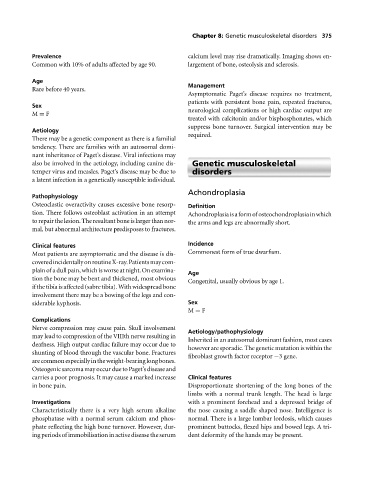Page 379 - Medicine and Surgery
P. 379
P1: KTX
BLUK007-08 BLUK007-Kendall May 12, 2005 19:48 Char Count= 0
Chapter 8: Genetic musculoskeletal disorders 375
Prevalence calcium level may rise dramatically. Imaging shows en-
Common with 10% of adults affected by age 90. largement of bone, osteolysis and sclerosis.
Age
Management
Rare before 40 years.
Asymptomatic Paget’s disease requires no treatment,
patients with persistent bone pain, repeated fractures,
Sex
neurological complications or high cardiac output are
M = F
treated with calcitonin and/or bisphosphonates, which
suppress bone turnover. Surgical intervention may be
Aetiology
required.
There may be a genetic component as there is a familial
tendency. There are families with an autosomal domi-
nant inheritance of Paget’s disease. Viral infections may
also be involved in the aetiology, including canine dis- Genetic musculoskeletal
temper virus and measles. Paget’s disease may be due to disorders
a latent infection in a genetically susceptible individual.
Achondroplasia
Pathophysiology
Osteoclastic overactivity causes excessive bone resorp- Definition
tion. There follows osteoblast activation in an attempt Achondroplasiaisaformofosteochondroplasiainwhich
torepairthelesion.Theresultantboneislargerthannor- the arms and legs are abnormally short.
mal, but abnormal architecture predisposes to fractures.
Clinical features Incidence
Most patients are asymptomatic and the disease is dis- Commonest form of true dwarfism.
coveredincidentallyonroutineX-ray.Patientsmaycom-
plain of a dull pain, which is worse at night. On examina-
Age
tion the bone may be bent and thickened, most obvious
Congenital, usually obvious by age 1.
if the tibia is affected (sabre tibia). With widespread bone
involvement there may be a bowing of the legs and con-
siderable kyphosis. Sex
M = F
Complications
Nervecompression may cause pain. Skull involvement
Aetiology/pathophysiology
may lead to compression of the VIIIth nerve resulting in
Inherited in an autosomal dominant fashion, most cases
deafness. High output cardiac failure may occur due to
however are sporadic. The genetic mutation is within the
shunting of blood through the vascular bone. Fractures
fibroblast growth factor receptor −3gene.
arecommonespeciallyintheweight-bearinglongbones.
OsteogenicsarcomamayoccurduetoPaget’sdiseaseand
carries a poor prognosis. It may cause a marked increase Clinical features
in bone pain. Disproportionate shortening of the long bones of the
limbs with a normal trunk length. The head is large
Investigations with a prominent forehead and a depressed bridge of
Characteristically there is a very high serum alkaline the nose causing a saddle shaped nose. Intelligence is
phosphatase with a normal serum calcium and phos- normal. There is a large lumbar lordosis, which causes
phate reflecting the high bone turnover. However, dur- prominent buttocks, flexed hips and bowed legs. A tri-
ing periods of immobilisation in active disease the serum dent deformity of the hands may be present.

